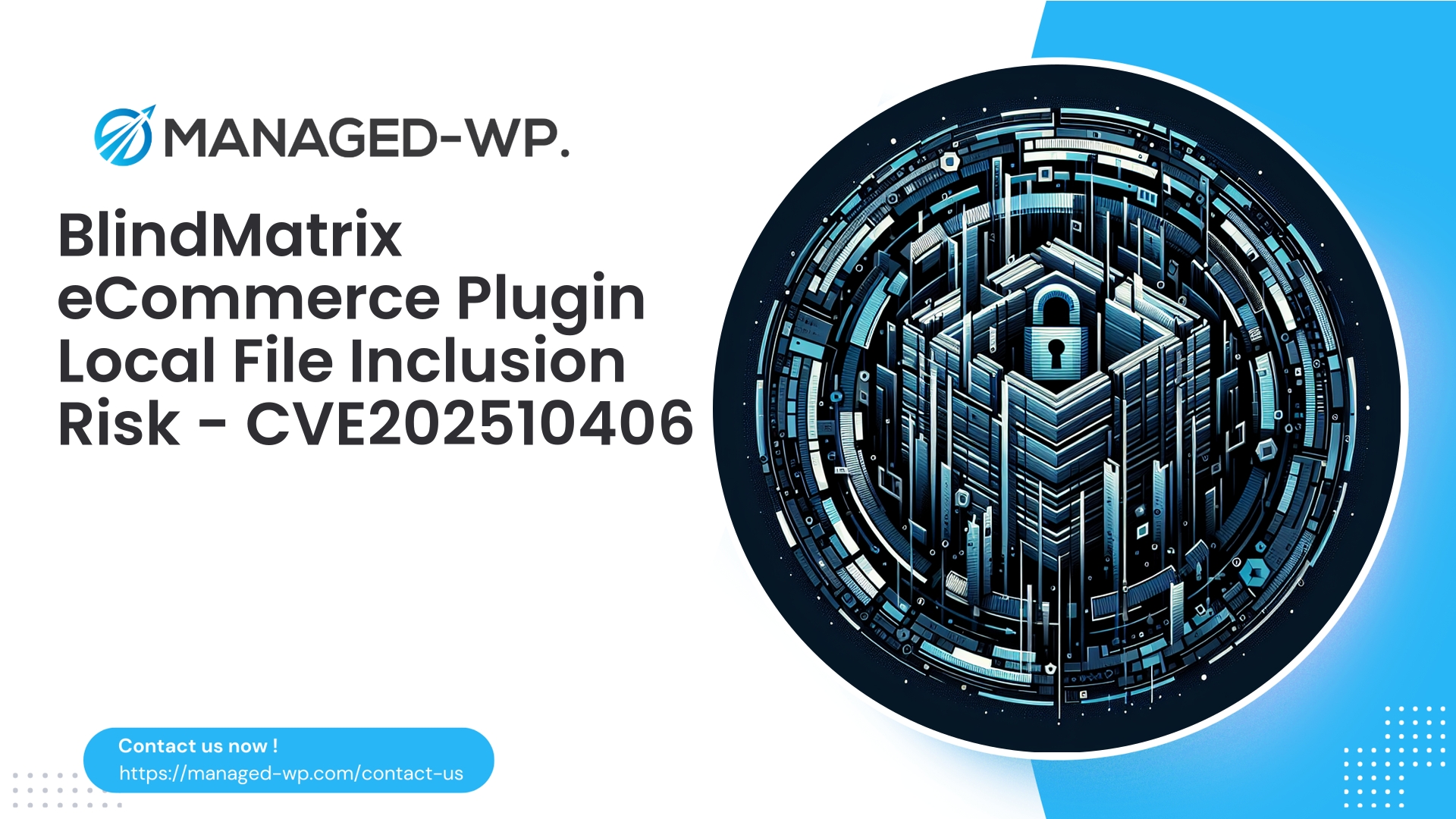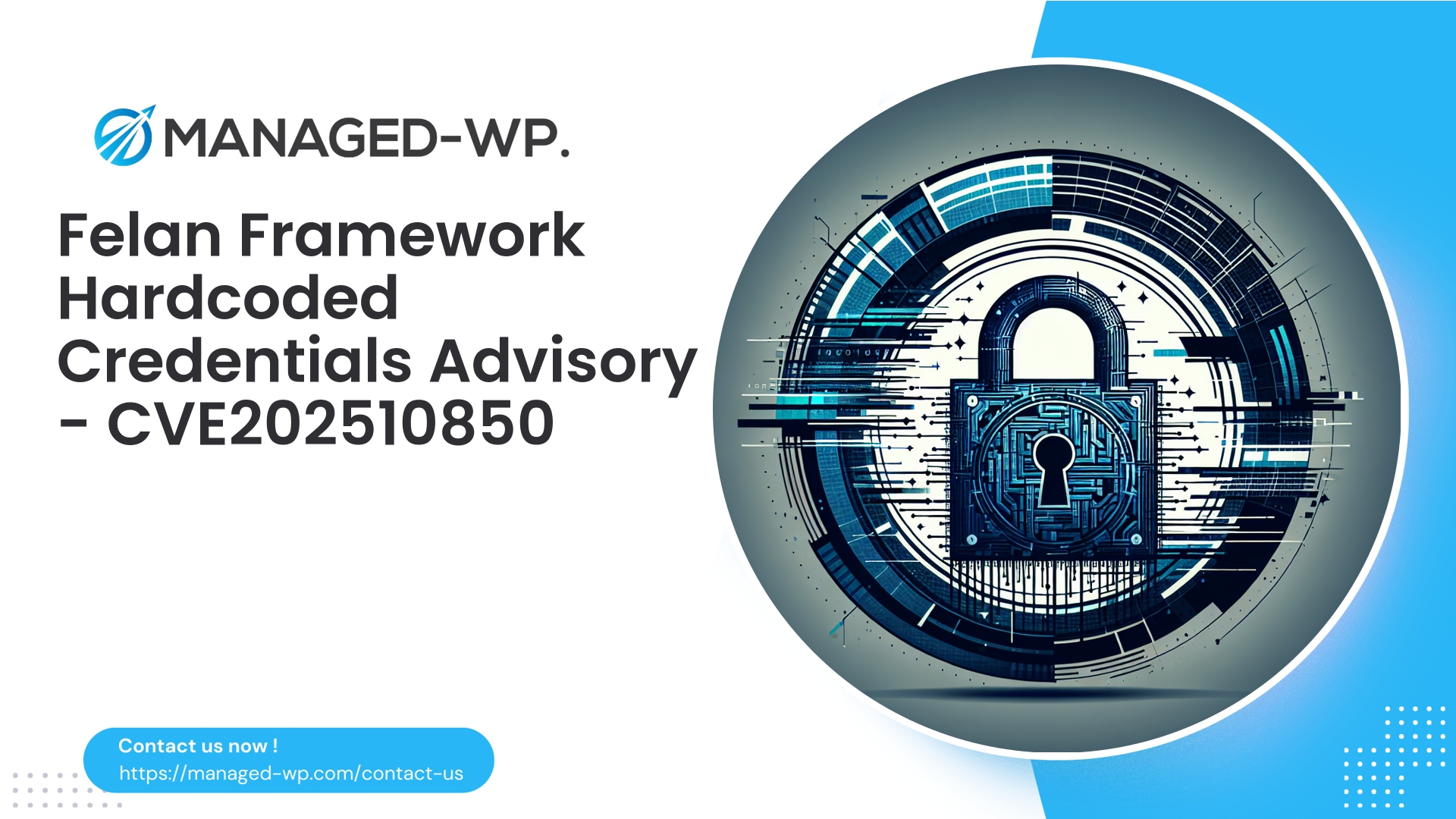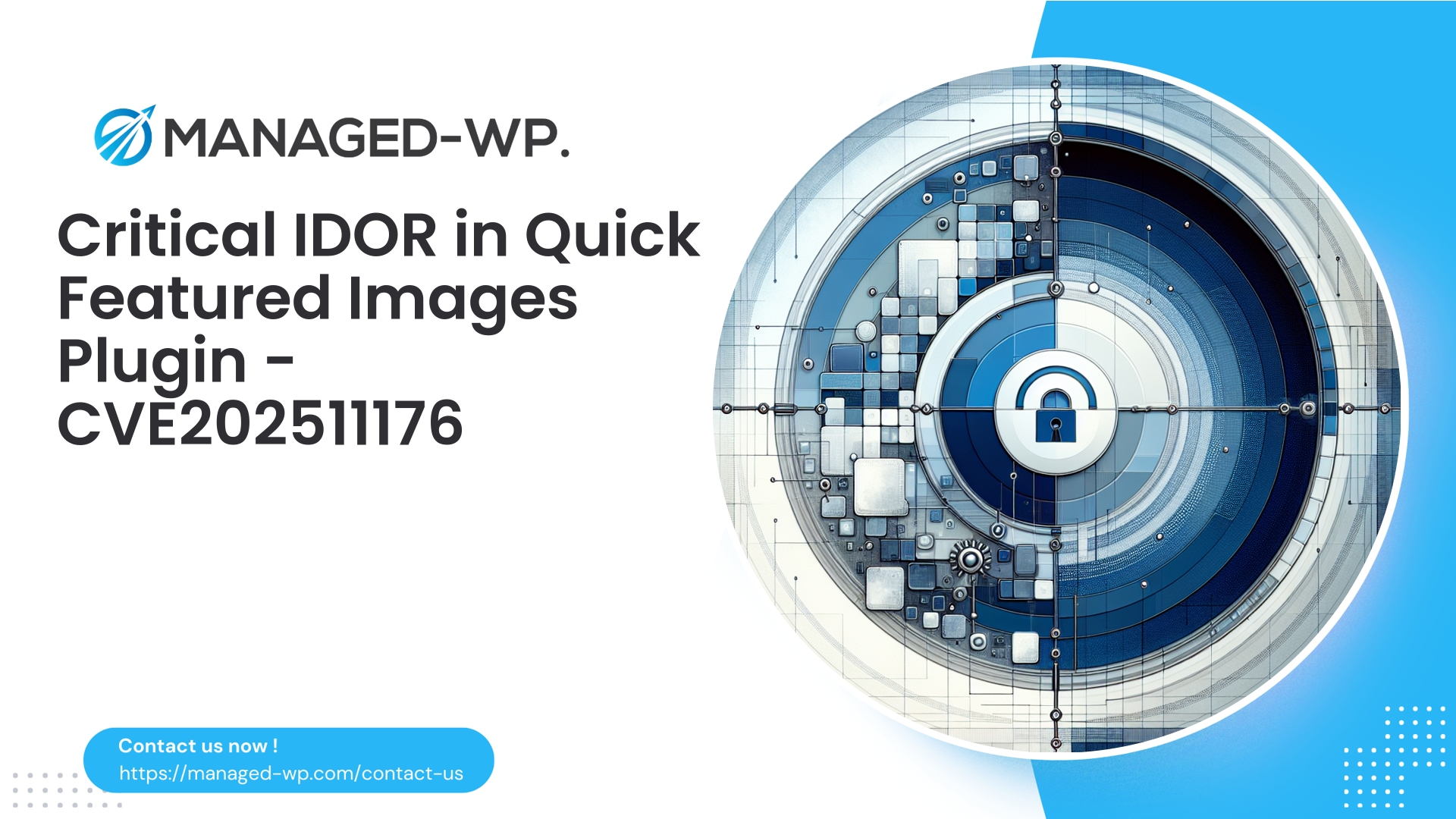| 插件名稱 | BlindMatrix 電子商務 |
|---|---|
| 漏洞類型 | 本機檔案包含 (LFI) |
| CVE編號 | CVE-2025-10406 |
| 緊急 | 低的 |
| CVE 發布日期 | 2025-10-16 |
| 來源網址 | CVE-2025-10406 |
BlindMatrix 電子商務外掛程式(< 3.1)— 貢獻者 LFI(CVE-2025-10406):WordPress 網站所有者需採取關鍵措施
發布日期: 2025年10月16日
作者: 託管式 WordPress 安全專家
Managed-WP 安全團隊緊急通報 BlindMatrix 電子商務外掛程式 3.1 版本之前的版本中發現的本機檔案包含 (LFI) 漏洞 (CVE-2025-10406)。該漏洞允許擁有貢獻者等級存取權限的攻擊者包含並輸出 WordPress 安裝中的本機文件,從而可能洩露資料庫憑證等敏感資訊。雖然利用此漏洞需要貢獻者憑證——這在一定程度上減少了匿名攻擊——但許多網站都存在此類帳戶,且帳戶被盜用的情況十分普遍,因此這仍然是一個值得關注的嚴重問題。
本分析概述了此漏洞的具體內容、如何偵測攻擊嘗試以及具體的緩解策略,包括短期和長期修復方案。我們還提供了客製化的 Web 應用程式防火牆 (WAF) 規則,您可以立即部署這些規則,在更新期間保護您的網站。
本文內容專為 WordPress 網站所有者、管理員和開發人員編寫,重點在於提供符合美國安全最佳實踐的可操作的專家指導。
摘要:事件經過及為何必須立即採取行動
- 漏洞: BlindMatrix 電子商務外掛程式(< 3.1)中的本機檔案包含 (LFI) 漏洞。已追踪,編號為 CVE-2025-10406。
- 風險: 擁有貢獻者權限的攻擊者可以請求本機網站檔案並取得其內容,從而可能暴露 wp-config.php 檔案、備份檔案、日誌等資訊。在特定條件下,本機檔案包含漏洞可能被利用來執行遠端程式碼執行 (RCE)。
- 所需存取等級: 貢獻者角色,可以創建和編輯內容,但缺乏完整的管理或外掛權限。
- 最終解決方案: 立即將 BlindMatrix 電子商務軟體升級至 3.1 或更高版本。
- 短期緩解措施: 部署針對常見本機檔案包含攻擊模式的網路應用防火牆(WAF)規則。審查使用者帳號和憑證是否有被入侵跡象。
了解貢獻者級本地文件包含漏洞的危險性
雖然要求貢獻者身分乍看之下似乎可以降低威脅,但由於以下因素,實際情況更為複雜:
- 開放的註冊機製或寬鬆的管理可能導致不受信任的使用者獲得貢獻者權限。
- 帳戶被盜用通常首先影響貢獻者帳戶,途徑包括憑證重用或網路釣魚。
- LFI 存取可能會暴露秘密文件,導致憑證被盜和權限提升。
此本地文件包含漏洞可能造成的後果包括:
- wp-config.php 檔案中的資料庫憑證外洩。
- 伺服器上系統檔案暴露,但伺服器安全措施不當(例如,/etc/passwd)。
- 日誌投毒攻擊,可導致遠端程式碼執行。
- 透過結合本機檔案包含漏洞和可寫檔案上傳漏洞來實現網站控制。
鑑於這些風險,場地所有者應迅速採取行動保護其環境。
這種本地文件包含漏洞通常是如何運作的
從宏觀層面來說,本地文件包含 (LFI) 是指基於使用者輸入而發生的不安全文件包含操作:
- 插件參數接受檔案路徑(例如,
?file=templates/header.php). - 該插件試圖在沒有嚴格驗證的情況下包含或讀取該檔案。
- 攻擊者提供路徑遍歷字串,例如
../../wp-config.php讀取敏感文件。 - 當執行包含的 PHP 程式碼或篡改日誌時,可能會導致程式碼執行。
由於貢獻者使用者可以存取易受攻擊的端點,因此控制貢獻者角色對於減少攻擊面至關重要。
偵測日誌中的本機檔案包含攻擊嘗試
要警惕以下可疑跡象,尤其是在涉及貢獻者帳戶的情況下:
- 包含目錄遍歷的請求:
../,..%2F, 或者..%252F. - 空位元組注入編碼:
%00. - 包含包裝:
php://,數據:,文件://,預計://. - 嘗試存取諸如此類的文件
wp-config.php,.env,/etc/passwd. - 針對插件端點的查詢參數包含可疑的鍵,例如
文件=,模板=, 或者包括=.
日誌中出現 LFI 攻擊嘗試的範例條目:
10.1.2.3 - contributorUser [16/Oct/2025:12:15:30 +0000] "GET /wp-admin/admin.php?page=blindmatrix&file=../../wp-config.php HTTP/1.1" 200 5623
其他警告訊號包括來自相同 IP 位址的重複編碼遍歷嘗試,或上傳檔案中出現意外的 PHP 檔案。
網站所有者和管理員應立即採取的緩解措施
- 立即更新 BlindMatrix 電子商務平台: 3.1 或更高版本包含必要的補丁。
- 限制貢獻者對易受攻擊端點的存取: 暫時撤銷貢獻者對外掛程式管理頁面的存取權限,直到問題修復為止。
- 審計用戶: 移除或降級不必要的貢獻者,以降低風險。
- 強制執行強憑證和多因素身份驗證 (MFA): 升級您的身份驗證控制。
- 輪換敏感憑證: 如果懷疑資料庫密碼和 API 金鑰遭到入侵,請變更這些密碼和金鑰。
- 掃描是否有入侵跡象: 使用信譽良好的惡意軟體掃描程序,檢查上傳的檔案是否有可疑的 PHP 檔案。
- 部署重點WAF規則: 使用下列範例規則立即阻止已知的本機檔案包含 (LFI) 模式。
- 停用 WordPress 文件編輯:
添加wp-config.php:定義('DISALLOW_FILE_EDIT',true);
- 停用上傳過程中的 PHP 執行: 請將此放入
wp-content/uploads/.htaccess對於 Apache:命令拒絕,允許拒絕所有
您可以立即實施WAF規則來加強您的網站安全。
以下是根據常見的本機檔案包含攻擊模式總結出的實用且經過測試的規則。在正式部署到生產環境之前,請先在測試環境中謹慎應用這些規則,以避免誤報。
ModSecurity 規則範例
# 偵測目錄遍歷嘗試 SecRule ARGS|ARGS_NAMES|REQUEST_URI "@rx (\.\./|\.\.%2[fF])" "id:1001001,phase:2,deny,log,status:403,msg:403,msg:' 潛在包裝器的 PHP 1656 603,msg:403,msg:403,msg: 的潛在包裝器使用功能SecRule ARGS|ARGS_NAMES|REQUEST_URI "@rx (php:|php://|data:|expect:|file://)" "id:1001002,phase:2,deny,log,status:403,msg:'潛在的本機檔案包含攻擊 - 或串流包裝器嘗試檢測"@rx (wp-config\.php|/etc/passwd|\.env|config\.inc|database\.sql)" "id:1001003,phase:2,deny,log,status:403,msg:'嘗試存取敏感檔案'"
NGINX + Lua 範例:阻塞編碼遍歷
if ($request_uri ~* "\.\./|%2e%2e%2f|%2e%2e/|%252e%252e") {
return 403;
}
Apache .htaccess 程式碼片段
<IfModule mod_rewrite.c>
RewriteEngine On
# Block traversal and access to sensitive files
RewriteCond %{QUERY_STRING} (?:\.\./|%2e%2e%2f|php://|/etc/passwd|wp-config\.php) [NC]
RewriteRule .* - [F,L]
</IfModule>
WordPress外掛程式級邏輯(偽代碼)
- 攔截插件端點,貢獻者角色可以存取這些端點。
- 如果任何參數包含以下內容,則拒絕請求。
../,php://或 base64 編碼的遍歷。 - 記錄此次嘗試並阻止該請求。
筆記: 測試和日誌記錄對於最大限度減少對合法用戶的影響至關重要。
偵測特徵和入侵指標 (IOC)
在日誌分析或 SIEM 工具中使用這些字串來偵測可疑活動:
../wp-config.php%2e%2e%2fphp://inputdata:text/plain;base64/etc/passwd- 上傳的 PHP 文件
wp-content/uploads/匹配.*\.(php|phtml) - 貢獻者使用者名稱向 BlindMatrix 插件頁面發出意外請求
grep 指令範例:
grep -E "(%2e%2e%2f|\.\./|php://|wp-config\.php|/etc/passwd)" /var/log/apache2/access.log
事件回應手冊:如果您懷疑有漏洞利用
- 隔離: 立即將網站置於維護模式或封鎖違規IP位址。
- 保存證據: 在進一步調查之前,請先建立完整的檔案系統和資料庫備份。
- 範圍: LFI 請求和意外文件內容外洩的稽核日誌。
- 檢查是否存在 Webshell: 審核可寫目錄,尋找惡意 PHP 或後門檔案。
- 資格認證輪替: 更改資料庫憑證和所有進階使用者密碼。
- 撤銷會話: 強制所有使用者登出並使活動令牌失效。
- 修補: 應用程式插件更新 — BlindMatrix 3.1 或更高版本。
- 清理: 刪除攻擊者建立的檔案/用戶,並加強伺服器配置。
- 事件後監測: 整改後數週內,加強日誌審查和流量分析。
- 開發人員協調: 如果涉及自訂程式碼,則需協作修復並進行全面測試。
如果內部資源不足,應立即尋求專業事件回應援助。
開發者指南:預防本地文件外洩的最佳實踐
外掛程式和主題開發者應採用以下策略,從設計上消除本機文件包含風險:
- 將文件加入白名單: 僅包含文件名或別名明確允許的文件,絕不能包含原始使用者輸入。
- 對輸入內容進行消毒: 使用 WordPress 函數,例如
sanitize_text_field()和wp_normalize_path(). - 使用 realpath 驗證路徑: 確保解析後的檔案路徑仍然位於您信任的插件目錄中:
$base_dir = realpath(plugin_dir_path(__FILE__) . 'templates/'); $requested = realpath($base_dir . '/' . $requested_file); if (1TP==4Trequested = fidal1450, falF)_strir454)4145)) !== 0) { // 拒絕:位於允許目錄之外 } - 在程式碼中將別名對應到檔案:
。
- 塊流包裝器: 禁止輸入包含冒號或無效字符的字符,以防止類似這樣的攻擊。
php://. - 能力檢查: 確認使用者擁有最低要求的角色,並實施 nonce/CSRF 保護。
- 自動化測試: 在您的 CI 管線中新增針對遍歷和惡意輸入的單元測試和模糊測試。
遵循這些最佳實踐是消除本地文件包含漏洞最有效的方法。
其他伺服器加固建議
- 停用 PHP 在上傳目錄和其他可寫目錄中的執行。
- 對檔案和目錄應用最小權限原則。
- 保持 PHP、WordPress、外掛程式和伺服器軟體完全更新。
- 使用單獨的服務帳戶來最大限度地減少權限範圍。
- 定期執行完整性掃描,比較檔案雜湊值,以偵測未經授權的變更。
- 維護經過測試的備份,包括本地備份和異地備份。
常見問題解答
問: 如果貢獻者能夠閱讀 wp-config.php網站是否立即遭到入侵?
一個: 並非立竿見影,但這至關重要,因為 wp-config.php 包含資料庫憑證。攻擊者可以遠端連接到資料庫(如果獲得授權),或利用洩漏的密鑰進行權限提升。如果懷疑憑證洩露,請立即輪換資料庫憑證。
問: 基於插件的惡意軟體掃描器能否偵測到本機檔案包含攻擊?
一個: 掃描器雖然有用,但僅靠掃描器是不夠的。它們可能會遺漏隱藏的後門或基於日誌的攻擊。因此,需要將掃描與強大的網路應用防火牆(WAF)規則、人工日誌審查和嚴格的存取控制相結合。
問: 正在阻塞 /etc/passwd 請求夠多嗎?
一個: 不。攻擊者會使用多種規避技術和編碼手段。包括打補丁、用戶管理、Web應用防火牆(WAF)和伺服器加固在內的多層防禦至關重要。
WAF簽章快速部署範例列表
- 區塊目錄遍歷序列編碼或原始(
../,%2e%2e%2f,%252e%252e). - 阻止危險的流包裝器,例如
php://,數據:,預計:,文件://. - 阻止對敏感文件的查詢(
wp-config.php,.env,/etc/passwd以及備份擴充)。 - 收到包含 PHP 來源指示符的 200 個回應的警報 (
$table_prefix,資料庫名稱)已返回給非管理員。
立即保護您的 WordPress 網站-試試 Managed-WP 的免費基本套餐
為了立即降低此類插件漏洞的風險,Managed-WP 提供免費的基礎套餐,包含基本的託管防火牆保護、高級 Web 應用防火牆 (WAF)、惡意軟體掃描以及針對 OWASP Top 10 風險的緩解措施——所有這些都提供無限頻寬。在您修補和保護網站的同時,還能隨時保持一層安全防護。
請在此註冊: https://my.wp-firewall.com/buy/wp-firewall-free-plan/
對於進階需求(例如自動刪除、IP 黑名單、虛擬修補程式和專用安全支援),Managed-WP 的付費方案提供增強的覆蓋範圍和專家協助。
最終立即行動清單
- 立即將 BlindMatrix 電子商務軟體更新至 3.1 或更高版本。
- 如果無法立即進行更新,請部署 WAF 規則以封鎖已知的 LFI 攻擊路徑。
- 審核所有使用者帳戶,並刪除或降低不必要的貢獻者的權限。
- 要求啟用多因素身份驗證,並強制執行嚴格的密碼原則。
- 檢查日誌中是否存在可疑的文件包含請求和意外的文件讀取。
- 檢查上傳檔案和可寫目錄是否有意外的 PHP 檔案或 webshell。
- 在不需要的地方停用 PHP 執行。
- 在進行任何更改之前,請建立不可更改、安全的備份。
- 如果懷疑存在本機檔案包含攻擊,請輪換資料庫和 API 憑證。
- 考慮註冊 Managed-WP 的免費基礎計劃,即可立即新增託管 WAF 和惡意軟體掃描功能。
閉幕致辭
本機檔案包含漏洞(例如 CVE-2025-10406)極為危險。它們可能洩露關鍵訊息,並導致網站完全被控制,尤其是在與其他漏洞結合使用時。雖然此漏洞需要「貢獻者」權限,但許多 WordPress 網站都擁有此類用戶,而帳戶被盜用是常見的攻擊途徑。
您的當務之急是更新 BlindMatrix 外掛程式、審核使用者角色並部署 WAF 防護規則。 Managed-WP 致力於為網站所有者提供高效的託管安全服務,旨在降低風險並提供專家指導以完成修復工作。
如果您在執行規則或應對事件方面需要協助,我們的安全專家隨時準備為您提供協助。
保持警惕,將權限管理視為安全要務,並及時應用插件更新。



















